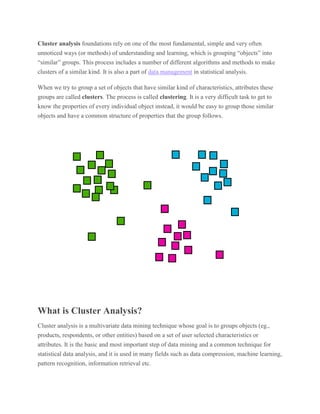Cluster analysis foundations.docx
Cluster analysis relies on grouping objects into similar clusters based on their characteristics. It is a technique used in data mining, machine learning, and statistical analysis to organize large datasets. There are several different clustering algorithms that group objects based on internal homogeneity and external heterogeneity when plotted geometrically. Common types of cluster analysis include hierarchical clustering which groups objects into clusters in a nested or tree structure, centroid-based clustering which assigns objects to the nearest cluster center, distribution-based clustering which groups objects that belong to the same statistical distribution, and density-based clustering which defines clusters by areas of higher density compared to other areas of the dataset.

Recommended
Recommended
More Related Content
Similar to Cluster analysis foundations.docx
Similar to Cluster analysis foundations.docx (20)
Recently uploaded
Recently uploaded (20)
Cluster analysis foundations.docx
- 1. Cluster analysis foundations rely on one of the most fundamental, simple and very often unnoticed ways (or methods) of understanding and learning, which is grouping “objects” into “similar” groups. This process includes a number of different algorithms and methods to make clusters of a similar kind. It is also a part of data management in statistical analysis. When we try to group a set of objects that have similar kind of characteristics, attributes these groups are called clusters. The process is called clustering. It is a very difficult task to get to know the properties of every individual object instead, it would be easy to group those similar objects and have a common structure of properties that the group follows. What is Cluster Analysis? Cluster analysis is a multivariate data mining technique whose goal is to groups objects (eg., products, respondents, or other entities) based on a set of user selected characteristics or attributes. It is the basic and most important step of data mining and a common technique for statistical data analysis, and it is used in many fields such as data compression, machine learning, pattern recognition, information retrieval etc.
- 2. Clusters should exhibit high internal homogeneity and high external heterogeneity. What does this mean? When plotted geometrically, objects within clusters should be very close together and clusters will be far apart. Related Articles: Data Collection And Organization Data Sets
- 3. Statistics Types of Cluster Analysis The clustering algorithm needs to be chosen experimentally unless there is a mathematical reason to choose one cluster method over another.It should be noted that an algorithm that works on a particular set of data will not work on another set of data. There are a number of different methods to perform cluster analysis. Some of them are, Hierarchical Cluster Analysis In this method, first, a cluster is made and then added to another cluster (the most similar and closest one) to form one single cluster. This process is repeated until all subjects are in one cluster. This particular method is known as Agglomerative method. Agglomerative clustering starts with single objects and starts grouping them into clusters. The divisive method is another kind of Hierarchical method in which clustering starts with the complete data set and then starts dividing into partitions. Centroid-based Clustering In this type of clustering, clusters are represented by a central entity, which may or may not be a part of the given data set. K-Means method of clustering is used in this method, where k are the cluster centers and objects are assigned to the nearest cluster centres.
- 4. Distribution-based Clustering It is a type of clustering model closely related to statistics based on the modals of distribution. Objects that belong to the same distribution are put into a single cluster.This type of clustering can capture some complex properties of objects like correlation and dependence between attributes.
- 5. Density-based Clustering In this type of clustering, clusters are defined by the areas of density that are higher than the remaining of the data set. Objects in sparse areas are usually required to separate clusters.The objects in these sparse points are usually noise and border points in the graph.The most popular method in this type of clustering is DBSCAN.